Update for May 2022! To download a 2-sided PDF handout of this article, click here. Please help educate as many people as possible by emailing or printing it out and handing it to those who need the information.
For years people have verbally attacked each other over what they thought they know to be true, especially where flag display is concerned. Even if you know what the Flag Code says and you politely try to correct someone about their display (hotel, business, school, etc.) you may receive an angry reply.
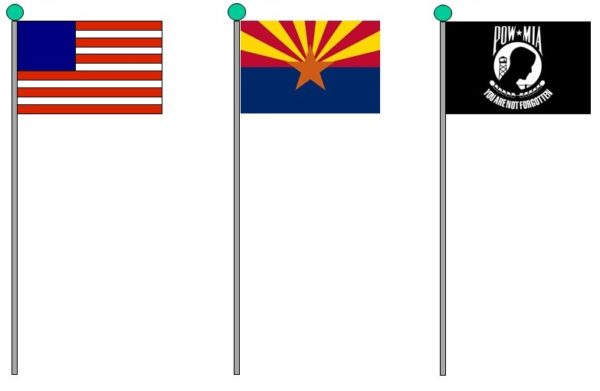
The above display is for every day of the year except for the six national observances, below. See also this article on POW/MIA Flag Protocol.
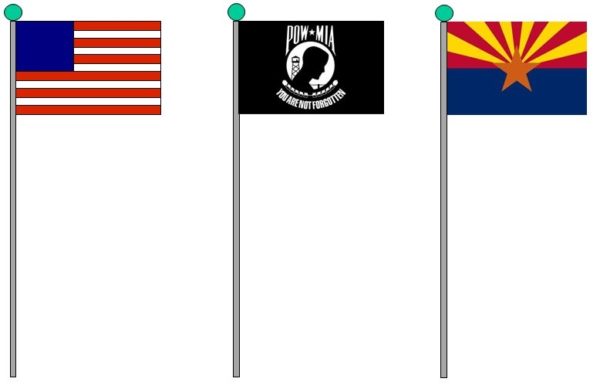
Authorized for six days each year. The six national observances are:
- National POW/MIA Recognition Day (third Friday of September)
- Armed Forces Day
- Memorial Day
- Flag Day
- Independence Day
- Veterans Day

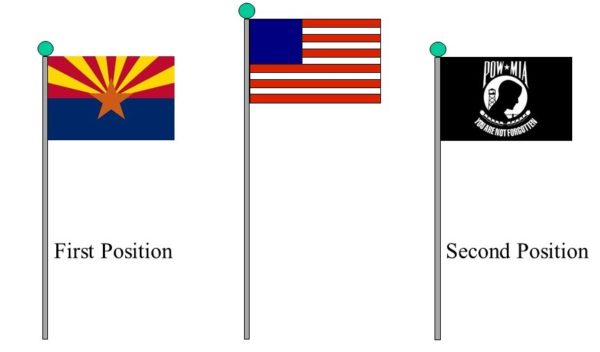
The only time the American flag is higher than the others is when it is displayed in the middle of other flags.
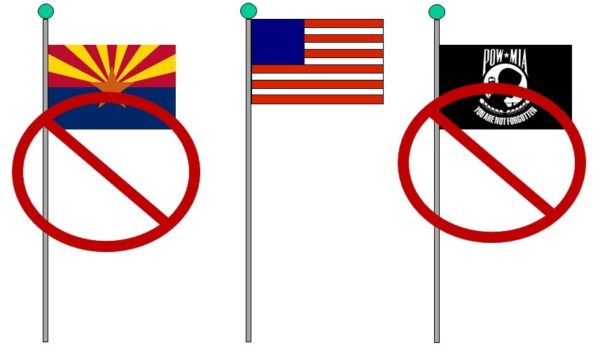
The above display is not appropriate since all of the flagpoles are the same height. The American flag should be at the viewer’s left, see the image at the very top.

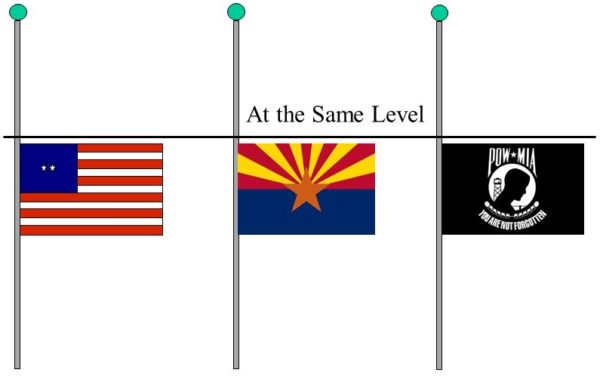
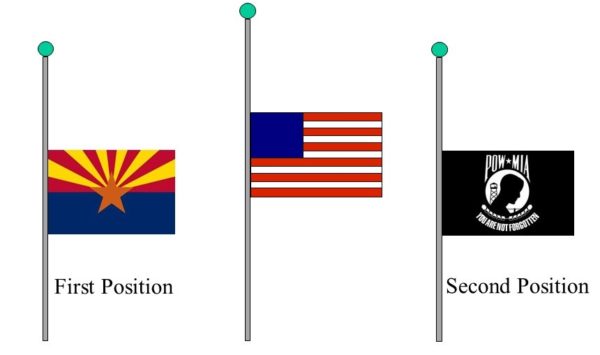
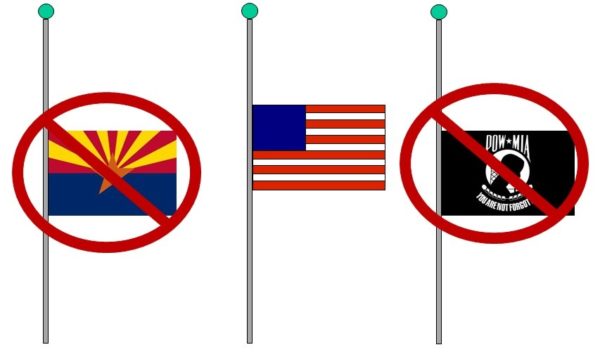


In the above image, this is appropriate half-staff display with one (or more) national flags. This goes for a foreign business located in the US and also military installations located overseas. Foreign national flags may not be brought to half-staff without that government giving its OK. Military installations overseas must contact the host nation liaison for permission to lower the host nation flag.


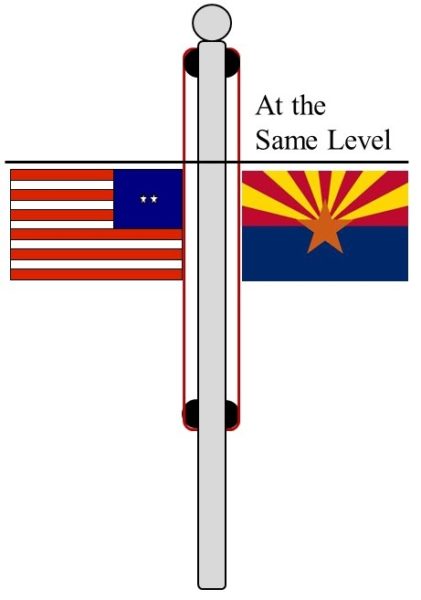
“Intended Direction of Display” is a term that I coined to help people understand the direction of display and the location for each of the flags in the display.






Comments 3
Yes. Based upon your material. I found the U. S. Flag in this 1931 or 1932 ceremony on the grounds of Camp Henry T. Allen, the Philippine Officers Academy (United States Administration) posted on the left with the Philippine National Flag posted at equal height on the left. Then out front the four soldiers of the Constabulary (their uniforms appeared to indicated they were not Cadets detailed to the flag corps) with the second from left (theirs) soldier dipping the Coat of Arms, which often represented the PCA (although I think there was another representation via appurtenances that never seem to be in focus in the photographs, that I have not seen imposed or superimposed upon any flag in any photo I’ve seen.) These old photographs were gathered over a long period of years by my grandfather and then placed into photo albums of a very old type, with the photos glued in. Once placed into the albums, I have no idea how often they might have been looked through, but probably not too often, if my grandfather was anything like most people. He left no instructions behind with regard to the photographs and scrap books, artifacts, etc. And only a picture of him in prep school was dated with a caption of his initials. And in 1926 and investigation that he did as a “Mission of One,” in Hawaii, detailed by Governor General Leonard Wood (former Chief of Staff, U. S. Army and MOH winner) of the Philippines to investigate Filipino labor conditions on Hawaiian Sugar Plantations, which were labelled for the study. Because the one photograph was never labeled, and because when I was a reserve in the Navy, I did almost no drilling in book camp, I had no idea by looking at the formations, what was going on. But when your article mentioned that military schools had functions such as a graduation, that is when the colors were often posted. The outdoor Parade grounds where the Companies were in formation, therefore were likely a portion of the graduation ceremonies of the Officers Academy. Also, it is likely that the Governor General and an audience were in attendance so that the Governor General could have his annual review. If this was 1931, Governor General Davis was serving or the Vice-Governor General.
However, if it was the 1932 Graduation the review would have been in front of Governor General Theodore Roosevelt (called Jr. or the III at times although his birth certificate said simply, “Theodore Roosevelt.” His father was President Teddy Roosevelt who finally earned his MOH posthumously for actions with the Rough Riders in Cuba. It was 12 years later in WW II that this son of Roosevelt, fairly recently promoted to Brigadier General had volunteered to jump onto Utah Beach during the Normandy D-Day invasion. Multiple written accounts of his heroism resulted in his nomination for the Medal of Honor which was very quickly and without dispute approved of by the President and Congress. A month later while still in France, Roosevelt suffered a heart attack and died. It is noted, that before his death, he was both promoted to Major General and also was ordered recalled to the war room at headquarters. sadly, he never heard of the promotion prior to his death.
Alex Ford
This is an amazing instructional. I read it in preparation of comments about an historic photograph of the U. S. Insular Period, likely the 1930’s in Baguio, Benguet, Philippine Islands, Camp Henry T. Allen, Philippine Constabulary Academy (probably the parade grounds) in which cadets with rifles are divided into left and right units (companies?) with a four man color guard having the two left and right men, all of the same approximate height, holding the rifles out in front, vertically. The American Flag is posted on the right and the Philippine flag is posted to the viewer’s right (left). The guard flagman has dipped the National Insignia crest/coat of arms flag at approximately 45 degrees. (There is an appurtenance I have seen on the color that is different from the coat of arms that represents the PCA, but I have not seen it on a flag in photographs.). The cadet, second from left, (viewer’s right), is the one holding and dipping the National Coat of Arms, Philippine Islands, flag. To his immediate right is a cadet holding what appears to be a bugle in the left hand at his side, held downward. There is not perfect focus in this old photograph and the negative was not dense, so pulling detail out of it is difficult or impossible. Based upon the information presented herein, I have concluded that this exercise is either a review/Inspection for the Governor-General of the P.I’s. and at the same time is either a practice for graduation of is part of the overall graduation ceremonies for review//inspection by the Superintendent of the academy. There is no inscription for the photograph. There are Baguio Pines in the background. All in all this black and white photograph is quite interesting with certain details of the posting of the colors with the third flag apparently representing the PCA being dipped. The two corps also have the rifles presented in front, vertically. There are also one cadet in front of the viewer’s left group, wearing on his sleeve a Sergeant’s chevron with a rocker under it standing at attention with sword at left side. Two more cadets are in the picture to the viewer’s left who appear to be standing further out front, located between the right company and the flag corps. The one closest to the flag corp has what appears to be the small corporal stripes on his coat. The Cadet to the front of him has what appear to be very large corporal stripes on the left sleeve of his coat. The cadets all have white pants and shoes and dark colored coats on, as their attire.. The hats are sort of fez type with bills in the front with the coats of arms cap badges on the front. The, “end rifles,” also had the flag-leather-suspenders moved to their left sides, during rifle-presentation sequence. There is only the one photograph. One person in civilian clothing appears off the grounds in the background. He may be a gardener for the Constabulary grounds, but one had to look carefully to find him in the photograph, in general is obscure enough not to subtract from the formality in the photograph. — Alex Ford, Simi Valley, Ca.
Author
Mr. Ford,
I’m glad you found the article useful!